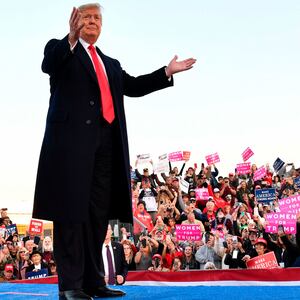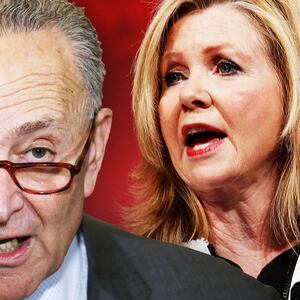With just a week until Election Day, President Trump has firmed up his immediate pre-election travel plans, and on first glance it looks like he’s playing it smart and safe, for once in his political life.
With high approval ratings among Republicans but still-weak favorability among the electorate at-large, and the House more likely to flip than the Senate, he’ll be focusing a lot of his attention on states he won in 2016 where Democratic senators are on the ballot: Florida, Missouri, West Virginia, Indiana, Montana, Ohio. Cook Political Report’s Amy Walter is dubbing it a “very strategically smart tour” that is “all about… really expanding the Senate.”
But look a little closer, and you’ll see the itinerary actually hints at Republican weaknesses that really shouldn’t even be present—and a tour that might just wind up helping, not hurting, Democrats.
ADVERTISEMENT
Let’s be honest: There’s very little obvious reason why states that Trump won by massive margins—like Indiana, Missouri, Montana and West Virginia—should still be in play for Democrats at all, especially after the Kavanaugh nomination, which unified various chunks of the GOP in a way nothing prior had during Trump’s tenure.
That they are still being heavily contested speaks to the fact that the GOP in the era of Trump really isn’t that saleable to most voters— even those in areas that overwhelmingly decided in 2016 that he was the better of two bad choices.
Sure, it also speaks to the fact that some unique, very well-tailored-to-their-states, or just plain lucky-as-a-magic-horseshoe senators currently occupy those seats (Joe Manchin falls in the former category, Claire McCaskill in the latter).
But fundamentally, that the GOP is a week away from the election and apparently has these races so insufficiently locked down that Trump has to go on the road to gin up and turn out the base is no good indicator for the GOP overall.
Here’s another: We’re told that only Arizona and Nevada remain real possibilities for Democrats picking up currently Republican-held Senate seats. But while Marsha Blackburn is more likely than not to win her Senate race in Tennessee, and on election day it might not end up being close, look at where Trump is making a stop in the Volunteer State: Chattanooga.
If you didn’t know, that’s the city retiring Sen. Bob Corker, whom Blackburn is seeking to replace, used to run as mayor.
Corker hasn’t exactly been an enthusiastic supporter of Blackburn. For starters, after initially announcing his retirement, he pondered jumping back into the race (possibly the ultimate diss to Blackburn). Then, he offered what was broadly described as a “tepid” endorsement in which he called Blackburn’s Democratic opponent, former Gov. Phil Bredesen, his “friend” and said he wouldn’t campaign against him. He also dubbed Bredesen an “outstanding public servant,” all of which has pissed off his fellow Republicans—especially Blackburn—royally, because it turns out that Tennessee has a glut of moderate Republicans, which he de facto represents.
Some big names in that camp have put financial backing behind Bredesen, perhaps emboldened by Corker’s lukewarm “support” for Blackburn. Viewed through this lens, Trump’s visit to Chattanooga suggests the White House, at least, thinks Blackburn doesn’t have her Senate race sewn up and that more Republicans on Corker’s home turf need to be activated in order for her to bank a win (though who knows if Trump, who has clashed with Corker plenty, is the right deal-closer here).
That leads to a second oddity with the Trump “final stretch” campaign tour: the way he’s being deployed might actually end up helping Democrats he’s trying to beat. Look more closely at where the president is scheduled to travel, and you’ll notice something interesting: a bunch of the planned stops are in college towns. And not college towns populated by out-of-state students at liberal arts colleges who aren’t as likely to be registered to vote in the states they live and study in; these are college towns full of in-state students who overwhelmingly will be registered to vote in the exact Senate races Republicans are targeting.
Columbia, Missouri, is home to the University of Missouri. It has more than 30,000 students. Odds are that like most student bodies, Mizzou’s are overwhelmingly more supportive of Democrats than Republicans. Want to bet that if Trump comes to town and delivers a typical fire-breathing speech, he motivates a bunch of otherwise apathetic students who might get drunk and binge-watch reality TV to instead go vote for McCaskill, while probably not juicing Republican numbers that much since the surrounding area is hardcore Republican anyway? This stop might be a gamble, even if it looks like an obvious move.
Ditto Huntington, West Virginia, home to 13,000-some students at Marshall University who again are overwhelmingly likely to be registered to vote in West Virginia and overwhelmingly more likely to align with Democrats than Republicans. And Bozeman, Montana, which is home to Montana State University, which is attended by about 17,000 students, at least 10,000 of whom are in-state. That may not sound like a lot, but in the 2014 Montana Senate race, only about 350,000 people voted; these numbers matter. And as any good student of politics will tell you, older voters can be reliably banked on to turn out, younger voters cannot. But motivate them and turn them out and you can change whole election results—in this case, in favor of Democrats.
What will ultimately happen with the Senate is, of course, uncertain; most political prognosticators feel far more comfortable and confident making projections and predictions regarding the House than the other chamber of Congress.
However, the Trump team’s final round of decision-making heading toward Election Day really looks like a case of high-risk, high-reward—the ultimate Trumpy approach to campaigns, but maybe not the wisest one after all.








